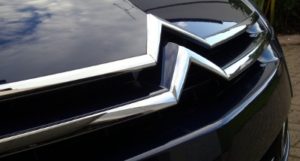Innovation and advanced engineering design have been the qualities attributed to big Citroëns over many decades.
Always different to other car makers since the marque came into being in 1919, Citroën has enjoyed a leading and trend-setting role in respect of radical styling and daring automotive technology that became firmly established with the introduction of the Traction Avant in 1934. Citroën’s prowess has been carried through successive generations of cars – the DS, SM, CX and XM, and now the C6.
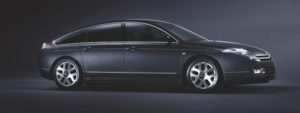
The genesis of the C6 can be traced to the late 1990s. The XM, which had been introduced in 1989, was nearing a decade of production, and for its successor to be fully appreciated by an ever critical car buying clientele, it had to be both futuristic in design as well as making a statement in terms of refinement and luxury.
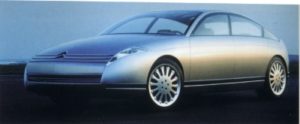
The prototype C6 was presented at the 1999 Geneva Motor Show. As expected, it was striking in appearance, had presence and immediately identified the Citroën ethos. Though Citroën is not a car maker to go down the retro route, the edict was that the car should take styling cues from the CX, which it mirrored in several aspects to include near identical dimensions of its wheelbase, its large front overhang and design of concave rear screen.
There was little doubt, so it seemed, that the C6 would enter production within a short timescale. However, when the XM went out of production in 2000, there was no sign of a successor. News of the new car kept emanating from Citroën, potential customers waited in anticipation, and kept waiting while the new C5 sufficed to satisfy the hiatus left by the C6’s non-appearance. When it was heard that the C6 project had been sent back to the drawing board, many marque enthusiasts questioned whether the car would ever appear.
The C6 was eventually introduced and, sensitively, its announcement coincided with the 50th anniversary of the DS in October 2005. The arrival of a large Citroën is always greeted with a mix of excitement, expectation and curiosity; the C6 being no exception. This really was the top of the Citroën range, exclusively appointed and, according to the manufacturer, assembled on a dedicated production line to ensure quality control. This was the car that, it was deemed, would rival the Germanic marques in terms of luxury and reliability. Big Citroëns have always been highly regarded for their comfort and ride quality, and in this case the C6 outstandingly upholds the Citroën tradition. The Hydractive technology provides probably the best ride of any car, even the most prestigious.
On introduction the model range included a V6 3.0 litre petrol-engined car, a four-cylinder 2.2 litre diesel and a 2.7 litre V6 diesel. The 2.2 litre proved to be a mix of the C6’s stunning styling but having a more modest specification to that reserved for more expensive versions. The V6 models, on the other hand, equalled their exterior shape with a level of performance described as being nothing less than athletic. The popular choice as far as the UK market was concerned was going to be the 2.7 litre V6 diesel (the same engine being used in the Jaguar S-type and its XF replacement), but that does not mean there was not a market for the 3.0 litre petrol-engined car. The latter has the advantage over the diesel in respect of performance and quietness, making it a truly luxurious vehicle which need not reflect excessive fuel consumption. Experience has shown that a petrol V6 car will average, as tested over a distance of 2,000 miles, between 28 and 34mpg taking into account all driving conditions. A 2.7 litre diesel V6 will be more economical over the same distance, averaging between 32 and 40mpg. Manual transmission is rare on a C6, the majority of cars having six-speed automatic gearboxes.
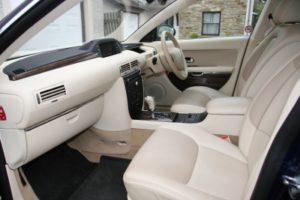 The specification of the C6 makes enticing reading. The top of the range Exclusive model has heated front seats that are electrically adjustable, the driver’s seat having two memory positions. The interior trim includes highest quality leather upholstery, the optional Lounge Pack rear seats being heated and having a recline facility. However, when the option is applied, the rear seat cannot be folded, which some people might find inconvenient.
The specification of the C6 makes enticing reading. The top of the range Exclusive model has heated front seats that are electrically adjustable, the driver’s seat having two memory positions. The interior trim includes highest quality leather upholstery, the optional Lounge Pack rear seats being heated and having a recline facility. However, when the option is applied, the rear seat cannot be folded, which some people might find inconvenient.
Throughout the range the dual zone climate control air conditioning, speed limiter, cruise control, parking sensors, directional headlights and an electrically operated parking brake are among the many features. The head-up display really does work and can be adjusted in terms of information required by the driver. Don’t expect a traditional dashboard; the futuristic digital instrumentation is all part of the C6’s futuristic appointment.
According to specification, the C6 employs slightly different electronics in terms of display, the heart of which is Citroën’s NaviDrive controlling navigation, audio and vehicle information functions. Exclusive models have a large screen onto which is projected the sat-nav and functional detail such as climate control, oil and coolant temperatures, tyre pressures and journey information in respect of distances travelled and average/instantaneous fuel consumption.
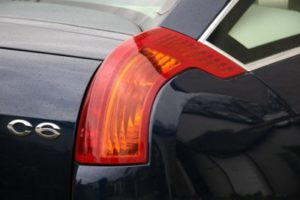 The C6 was never expected to sell in any great numbers in the UK, the estimation being no more than 1000 units, thus making it a rare and exclusive luxury machine. Most people who have driven the car have remarked about its smoothness and comfort along with its art deco appeal highlighted by its interior arrangement and external lighting design. Just like the Traction Avant, DS, CX and XM before it, the C6 will continue to endorse the marque as being a landmark in the world of automotive design.
The C6 was never expected to sell in any great numbers in the UK, the estimation being no more than 1000 units, thus making it a rare and exclusive luxury machine. Most people who have driven the car have remarked about its smoothness and comfort along with its art deco appeal highlighted by its interior arrangement and external lighting design. Just like the Traction Avant, DS, CX and XM before it, the C6 will continue to endorse the marque as being a landmark in the world of automotive design.
Buying advice
Owing to the fact that so few C6s have been supplied to the UK market, little can be said on what to pay for a suitable car. New, the list price extends to around £40k with all options, but there are currently some very good deals in terms of nearly new demonstrators being offered for sale through official Citroën dealers as well as certain independent specialists. Examples one to two years old, again demonstrators with minimal mileage, can be sourced through the official dealer network at prices often half (or less than half) the original price tag. Buying a car privately does call for some care, so check the mileage and look for any bodywork or alloy wheel damage. Check, too, that the interior has been carefully looked after and is not damaged or stained. The service record should be complete and have an official dealer’s stamp.
Problems or otherwise associated with the C6.
That the C6 is a comfortable car there is no doubt. The Hydractive suspension is totally reliable to provide ride and roadholding qualities second to none.
As with a lot of other cars that sport complicated electronics, there is built into the electrics an economy mode which is designed to safeguard the vehicle’s battery. This means that at certain times the electrical system closes down to allow only essential functions. Boot locks have been a problem with the C6 and C5 ranges of cars and there are reports that boot lids have become jammed in the closed position. On C6s with Lounge Pack rear seats this is all the more inconvenient as the seats cannot be folded so as to allow access to the boot lock from the interior. The mechanism can be released through a dealer’s diagnostic computer programme, and on a number of vehicles boot locks have been replaced.
On some cars the NaviDrive system has had to be re-booted and updated by the Citroën dealer network.
For owners wanting to tow caravans, the C6 (and the C5) has a low towing weight, which might question it as being suitable for such work.
As from late 2009, C6s are being fitted with a new 3.0 litre diesel engine which is also destined for the Jaguar range. It is claimed as being more frugal the 2.7 litre it replaces, as well as having considerably lower C0² emissions, thus making it more appealing in respect of vehicle excise tax.
Some owners have reported excessive tyre noise owing to the type of semi-low profile tyres specified. It is usual to replace front tyres at around 16000-18,000 miles, but renewal can be as low as 14,000 depending on driving characteristics. Rear tyres should last 25,000 to 30,000 miles.
The C6 has achieved some moderate popularity in mainland Europe and is set to become one of the most sought after ‘niche’ models in the Citroën catalogue.
